GALEX Press Releases
-

Press Release: Merging Stars Produce Glowing Blue Ring Nebula
Astronomers solve 16-year old mystery of ultraviolet ring in space
-

Press Release: NASA Decommissions Its Galaxy Hunter Spacecraft
NASA has turned off its Galaxy Evolution Explorer after a decade of operations in which the venerable space telescope used its ultraviolet vision to study hundreds of millions of galaxies across 10 billion years of cosmic time.
-

From National Astronomical Observatory of Japan: Discovery of a Blue Supergiant Star Born in the Wild
A duo of astronomers, Dr. Youichi Ohyama (Institute of Astronomy and Astrophysics, Academia Sinica or ASIAA, Taiwan) and Dr. Ananda Hota (UM-DAE Centre for Excellence in the Basic Sciences or CBS, India), has discovered a Blue Supergiant star located far beyond our Milky Way Galaxy in the constellation Virgo.
-

Press Release: NASA's Galex Reveals the Largest-Known Spiral Galaxy
The spectacular barred spiral galaxy NGC 6872 has ranked among the biggest stellar systems for decades. Now a team of astronomers from the United States, Chile and Brazil have crowned it the largest-known spiral based on archival data from NASA's Galaxy Evolution Explorer mission.
-

Press Release: NASA Lends Galaxy Evolution Explorer to Caltech
NASA is lending the Galaxy Evolution Explorer (GALEX) to the California Institute of Technology (Caltech) in Pasadena, where the spacecraft will continue its exploration of the cosmos.
-
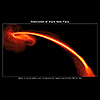
Press Release: Black Hole Caught Red-Handed in a Stellar Homicide
Astronomers have gathered the most direct evidence yet of a supermassive black hole shredding a star that wandered too close.
-
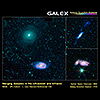
From Harvard-Smithsonian Center for Astrophysics: The Spitzer Photo Atlas of Galactic "Train Wrecks"
Five billion years from now, our Milky Way galaxy will collide with the Andromeda galaxy. This will mark a moment of both destruction and creation.
-
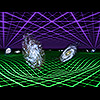
Press Release: NASA's Galaxy Evolution Explorer Helps Confirm Nature of Dark Energy
A five-year survey of 200,000 galaxies, stretching back seven billion years in cosmic time, has led to one of the best independent confirmations that dark energy is driving our universe apart at accelerating speeds.
-
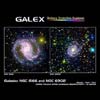
Press Release: Galaxies Demand a Stellar Recount
For decades, astronomers have gone about their business of studying the cosmos with the assumption that stars of certain sizes form in certain quantities.
-

Press Release: NASA Joins 'Around the World in 80 Telescopes'
A collection of NASA missions will be involved in a live event Friday, April 3, that will allow the public to get an inside look at how these missions are run. "Around the World in 80 Telescopes" is a 24-hour webcast that is part of the "100 Hours of Astronomy" event for the International Year of Astronomy 2009.
-
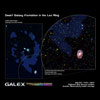
Press Release: New Recipe for Dwarf Galaxies: Start with Leftover Gas
There is more than one way to make a dwarf galaxy, and NASA's Galaxy Evolution Explorer has found a new recipe.
-
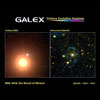
Press Release: 'Ghost of Mirach' Materializes in Space Telescope Image
NASA's Galaxy Evolution Explorer has lifted the veil off a ghost known to haunt the local universe, providing new insight into the formation and evolution of galaxies.
-

From University of Oxford: Ultraviolet Gives View Inside Real ‘Death Star’
Scientists have, for the first time, observed a flash of ultraviolet light from within a dying star giving vital evidence of how stars turn into supernovae.
-
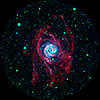
Press Release: Stellar Birth in the Galactic Wilderness
A new image from NASA's Galaxy Evolution Explorer shows baby stars sprouting in the backwoods of a galaxy -- a relatively desolate region of space more than 100,000 light-years from the galaxy's bustling center.
-

Press Release: Speeding Bullet Star Leaves Enormous Streak Across Sky
NASA's Galaxy Evolution Explorer has spotted an amazingly long comet-like tail behind a star streaking through space at supersonic speeds. The star, named Mira after the Latin word for "wonderful," has been a favorite of astronomers for about 400 years. It is a fast-moving, older star called a red giant that sheds massive amounts of surface material.
-
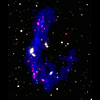
From NRAO: "Missing Mass" Found in Recycled Dwarf Galaxies
Astronomers studying dwarf galaxies formed from the debris of a collision of larger galaxies found the dwarfs much more massive than expected, and think the additional material is "missing mass" that theorists said should not be present in this kind of dwarf galaxy.
-
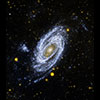
Press Release: 'That's Hot!' GALEX Celebrates Four Years in Space
NASA's Galaxy Evolution Explorer is celebrating its fourth year in space with some of M81's "hottest" stars.
-
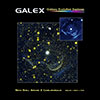
Press Release: GALEX Finds Link Between Big and Small Stellar Blasts
Proof that certain double star systems can erupt in full-blown explosions and then continue to flare up with smaller bursts has been spotted by the ultraviolet eyes of NASA's Galaxy Evolution Explorer.
-
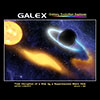
Press Release: NASA Telescope Sees Black Hole Munch on a Star
A giant black hole has been caught red-handed dipping into a cosmic cookie jar of stars by NASA's Galaxy Evolution Explorer. This is the first time astronomers have seen the whole process of a black hole eating a star, from its first to nearly final bites.
-

Press Release: Huge Black Holes Stifle Star Formation
Supermassive black holes in some giant galaxies create such a hostile environment, they shut down the formation of new stars, according to NASA Galaxy Evolution Explorer findings published in the August 24th issue of Nature.
-
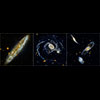
Press Release: Triple Scoop of Galactic Goodies
NASA's Galaxy Evolution Explorer dishes up a feast of cool cosmic treats from its first three years in orbit.
-
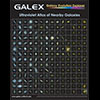
Press Release: GALEX Distributes Local Galactic Treasures at AAS
From sparkling blue rings to dazzling golden disks, Galaxy Evolution Explorer (GALEX) scientists are handing out a collection of their finest galactic treasures at the January 2006 American Astronomical Society meeting in Washington, D.C.
-
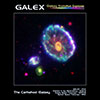
Press Release: Cartwheel Galaxy Makes Waves in New NASA Image
A new image from NASA's Galaxy Evolution Explorer completes a multi-wavelength, neon-colored portrait of the enormous Cartwheel galaxy after a smaller galaxy plunged through it, triggering ripples of sudden, brief star formation.
-
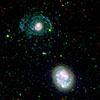
Press Release: NASA Telescope Reveals Nearby Galaxy's Invisible Arms
A new image from NASA's Galaxy Evolution Explorer shows that a galaxy once thought to be rather plain and old is actually endowed with a gorgeous set of young spiral arms.
-
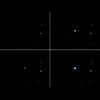
Press Release: NASA Telescope Catches Surprise Ultraviolet Light Show
It was a day like any other for a nearby star named GJ 3685A until it suddenly exploded with light. At 2 p.m. Pacific time, April 24, 2004, the detectors on NASA's Galaxy Evolution Explorer ultraviolet space telescope nearly overloaded when the star abruptly brightened by a factor of at least 10,000. After the excitement was over, astronomers realized that they had just recorded a giant star eruption, or flare, about one million times more energetic than those from our Sun.
-
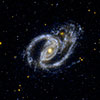
Press Release: Galaxy Evolution Explorer Turns Two
NASA's Galaxy Evolution Explorer, which observes galaxies in ultraviolet light, is celebrating its launch anniversary, April 28, 2003. The mission's observations will help scientists understand how galaxies, the basic structure of the universe, evolve and change.
-
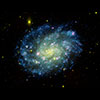
Press Release: Spiral Galaxy Puts on the Glitz
This color composite image of nearby NGC 300 combines the visible-light pictures from Carnegie Institution of Washington's 100-inch telescope at Las Campanas Observatory (colored red and yellow), with ultraviolet views from NASA's Galaxy Evolution Explorer. Galaxy Evolution Explorer detectors image far ultraviolet light (colored blue).
-

Press Release: Aging Universe May Still Be Spawning Massive Galaxies
NASA's Galaxy Evolution Explorer has spotted what appear to be massive "baby" galaxies in our corner of the universe. Previously, astronomers thought the universe's birth rate had dramatically declined and only small galaxies were forming.




